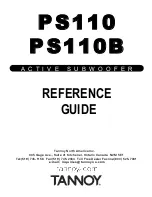
RS
HARDWARE
SETUP
PROCEDURE
Page
16
/
76
System Manual RS Series
5
RS HARDWARE SETUP PROCEDURE
Before proceeding with assembly of RS arrays, please ensure that the components are present and undamaged. A component
list is appended to this manual. In the event of any shortage, please contact your supplier.
For maximum efficiency the RS rigging system requires three experienced persons for set-up: typically, one motor hoist operator,
and one operator per side of the array. Good synchronisation and crosscheck between the operators are key elements for a
reliable and safe set-up.
5.1
Safety first
RS Rigging System structural computations and related documents are available in NS-1 or at NEXO ([email protected]) upon
request.
We include this section to remind you of safe practice when flying the RS system. Please read it carefully. However, user must
always apply his or her knowledge, experience and common sense. If in any doubt, seek advice from your supplier or NEXO
agent.
This manual offers guidance only for RS systems. References in this manual to other rigging equipment such as motor hoists,
steels, shackles etc. are made to clarify the description of rigging procedures. The user must ensure that operators are properly
trained by other agencies in the use of these items.
The RS Rigging System has been optimised for the deployment of vertical arrays of RS loudspeakers. No angle adjustment is
allowed between cabinets.
The RS Rigging System is a professional RS Rigging System and provided with suitable safety equipment should deploy RS
Arrays. Misuse of the RS Rigging System could lead to dangerous consequences.
Used and maintained correctly, the RS Rigging System will give many years of reliable service in portable systems. Please take
the time to read and understand this manual. Cluster configuration must be implemented and validated in NS-1 prior to
installation.
5.1.1
Flown systems safety
Always inspect all the rigging components and cabinets for damage before assembly. Pay special attention to the lifting points,
and safety clips. If you suspect that any of the components are damaged or defective, DO NOT USE THE AFFECTED PARTS.
Contact your supplier for replacements.
Read this manual carefully. Also, be familiar with the manuals and safe working procedures for any ancillary equipment that will
be used with the RS Rigging System.
Cluster configuration must be implemented and validated in NS-1 prior to installation.
Ensure that all local and National regulations regarding the safety and operation of flying equipment are understood and adhered
to. Information on these regulations can usually be obtained from Local Government Offices.
When deploying a RS system always wear protective headwear, footwear and eye protection.
Do not allow inexperienced persons to handle a RS system. Installation personnel should be trained in loudspeaker flying
techniques and should be fully conversant with this manual.
Ensure that motor hoists, hoist control systems and ancillary rigging components are currently certified as safe and that they
pass a visual inspection prior to use.
Ensure that public and personnel are not allowed to pass beneath the system during the installation process. The work area
should be isolated from public access.
Never leave the system unattended during the installation process.
Do not place any object, no matter how small or light, on top of the system during the installation procedure. The object may fall
when the system is flown and is likely to cause injury.
Secondary safety steels must be installed once the system has been flown to the operating height. Secondary steels must be
fitted irrespective of requirements of the local safety standards applicable to the territory.
Ensure that the system is secure and prevented from pivoting around the motor hoist.
Avoid any form of excessive dynamic loading to the assembly (structural computations on RS Rigging System are based on a
1/1.2 factor for hoist or motor acceleration).
NEVER attach any item to the RS system other than the RS accessories.
When flying outdoor systems ensure that the system is not exposed to excessive wind or snow loads and is protected from
rainfall.
In case of wind greater than 8 on Beaufort scale (72km/h
– 45mph), a touring system has to be landed or an additional securing
has to be implanted.
Summary of Contents for RS Series
Page 1: ...DP5235 01 CM RS Series RS15 RS18 Subwoofers System manual ...
Page 12: ...CONNECTION DIAGRAMS Page 12 76 System Manual RS Series 3 3 RS15 NXAMP4x2mk2 4 channels mode ...
Page 13: ...CONNECTION DIAGRAMS System Manual RS Series Page 13 76 3 4 RS15 NXAMP4x4mk2 4 channels mode ...
Page 14: ...CONNECTION DIAGRAMS Page 14 76 System Manual RS Series 3 5 RS18 NXAMP4x4mk2 4 channels mode ...
Page 60: ...TECHNICAL SPECIFICATIONS Page 60 76 System Manual RS Series 8 2 2 Dimensions mm inches ...
Page 66: ...TECHNICAL SPECIFICATIONS Page 66 76 System Manual RS Series 8 3 6 RSI INSP15 Parts X4 X8 X8 ...
Page 75: ...USER NOTES System Manual RS Series Page 75 76 10 USER NOTES ...
















































